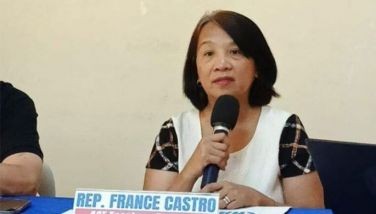Generals also serve who only stand, wait

WAITING GAME: What’s happening to the country, general? Waiting, it seems — if this story told us by a military type is true.
Last Jan. 11 daw, 13 newly promoted generals cooled their heels at the Bahay Pangarap, the presidential residence across the river from Malacañang, waiting for the Commander-in-Chief to administer their oaths.
They had been waiting for almost two hours when a jubilant Joshua reportedly emerged from a room shouting “Natalo ko rin siya!” followed shortly by his uncle the President.
The oath-taking that followed took no more than 30 seconds. Most senior in the pack was Lt. Gen. Juancho M. Sabban, Western Command chief. The rest were brigadier and major generals. Also present were the major service commanders and the armed forces chief of staff.
* * *
CALL ON THE CHIEF: It has been said that they also serve who only stand and wait, but it is waste of time and manpower to have star officers waiting.
Last Jan. 1, the generals were waiting for Malacañang to schedule them for the traditional call on the Chief at the start of a new year. No such call happened on that red-letter day.
The generals’ call on the President finally took place Jan. 4 — not at Malacañang as tradition would have it, but at the Navy headquarters on Roxas Blvd.
The program was piggy-backed on the ceremony for the assumption by Rear Admiral Alexander P. Pama as the 32nd flag officer in command of the Navy.
* * *
POLICY CHANGES: With a power crisis looming in the horizon, the government should be courting investors instead of scaring them with sudden policy changes after they have plunked in huge outlays for generating electricity.
The threat of the Quezon provincial government to auction off the 735-megawatt Pagbilao coal-fired facility on Jan. 26 over the failure of the National Power Corp. to pay realty taxes on the plant and its equipment illustrates this point.
When the private consortium TeaM Energy Corp. took over Pagbilao in the 1990s, it was made clear in the contracts with the Napocor that realty taxes were not the obligation of the investor but of the latter.
Remember back then that we were in the midst of darkness, enduring rotating blackouts. Government would have given the sun and the moon to investors who could stabilize our power supply.
* * *
TAX AVOIDANCE: But after TeaM Energy came in with something like $800 million and started operating Pagbilao, the Napocor told Quezon tax collectors hounding it that it was exempt from paying realty taxes because it was a government entity.
The local government questioned Napocor’s tax avoidance ploy and sued, eventually winning its case in the Supreme Court. The tribunal ruled that real property taxes must be paid.
Still unable to collect from Napocor the taxes now running to around P6.5 billion, the province decided to train its guns on the plant operator, TeaM Energy, demanding that it pay Napocor’s obligation or else.
The idea probably is that with its billions in investments threatened, TeaM Energy may be easier to pressure. But is this the right way to treat investors?
* * *
IS IT JUST?: The ruling of the US District Court in Hawaii that Marcos wealth be used to compensate Filipino victims of human rights violations during martial rule has raised questions over its being just and enforceable.
The first question is why only 7,526 victims are to be paid. Is this fair to other victims, who number tens of thousands but who were excluded from the class suit by the lawyers?
The reason given was that other victims did not sign up or were removed from the list. Even then, that does not erase the fact that many abuse victims entitled to compensation had been left out.
The original amount awarded by District Judge Manuel Real of Honolulu was $2 billion. This was later reduced, but it indicates the court’s intention to have all claims paid from Marcos assets that may be unearthed.
If more Marcos wealth is found in the US later, will this be given out, as additional payment, only to the exclusive circle of 7,526 beneficiaries?
* * *
DEGREE OF DAMAGE: Why a uniform $1,000 payment per claimant? Was the degree of damage the same for all? Should a Filipino who lost an eye be treated similarly as a coed who was tortured, raped and eventually killed?
The $1,000 payment was arrived at after the lawyers and informers took 25 percent of the $10 million from Marcos assets in Texas and Colorado and the balance of $7.5 million divided by the number of claimants on the list.
If the $1,000 is just a partial payment to be augmented when more Marcos properties are found, does it mean that the list of claimants is closed? All Marcos wealth has been earmarked only for the 7,526 on the final list?
Are those who are not on the list submitted to Judge Real barred from sharing present and future payments even if they suffered as much as, or even more than, some of those listed?
* * *
PIN THE BLAME: The ruling of the US court is not fair to most victims of human rights violations. The Philippine government should step in to ensure fairness.
Why compensate only victims of the Marcos regime? Are victims under other administrations after Marcos less entitled to restitution?
Who should pay for the damage? Is the torture inflicted a personal responsibility of whoever was the head of government at the time? Or is this a failure and a responsibility of the government?
If the head of government (e.g. Marcos) is responsible, should the damage be paid from his personal or family resources?
These are some of the myriad questions that the Real decision has raised because it is clearly not fair and well-thought out.
* * *
ePOSTSCRIPT: Read past POSTSCRIPTs at www.manilamail.com. E-mail feedback to fdp333@ yahoo.com
- Latest
- Trending






























